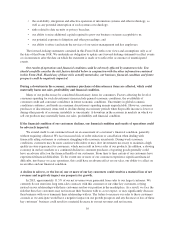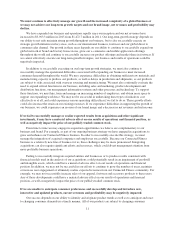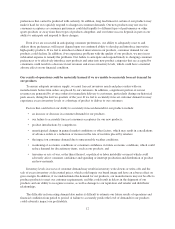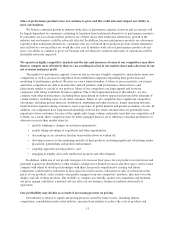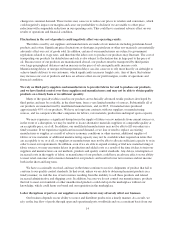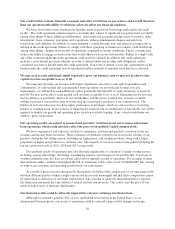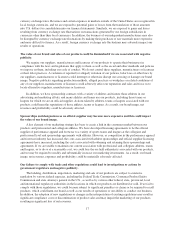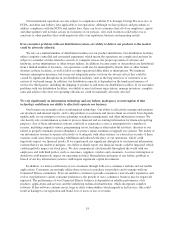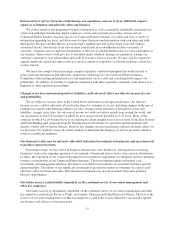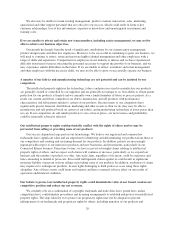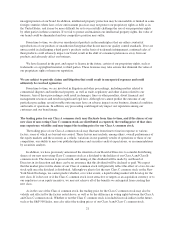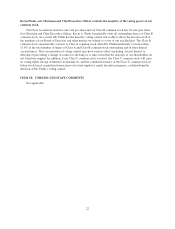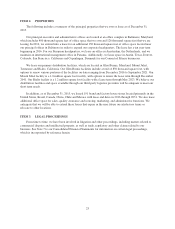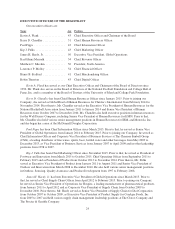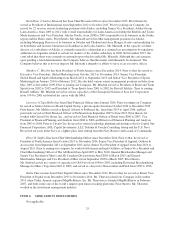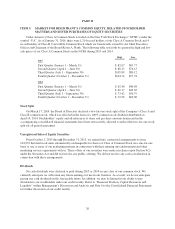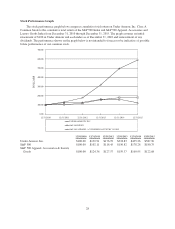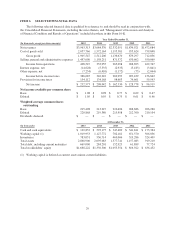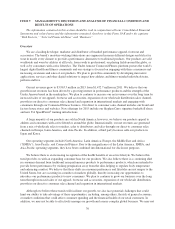Under Armour 2015 Annual Report Download - page 28
Download and view the complete annual report
Please find page 28 of the 2015 Under Armour annual report below. You can navigate through the pages in the report by either clicking on the pages listed below, or by using the keyword search tool below to find specific information within the annual report.We also may be unable to retain existing management, product creation, innovation, sales, marketing,
operational and other support personnel that are critical to our success, which could result in harm to key
customer relationships, loss of key information, expertise or know-how and unanticipated recruitment and
training costs.
If we are unable to attract and retain new team members, including senior management, we may not be
able to achieve our business objectives.
Our growth has largely been the result of significant contributions by our current senior management,
product design teams and other key employees. However, to be successful in continuing to grow our business, we
will need to continue to attract, retain and motivate highly talented management and other employees with a
range of skills and experience. Competition for employees in our industry is intense and we have experienced
difficulty from time to time in attracting the personnel necessary to support the growth of our business, and we
may experience similar difficulties in the future. If we are unable to attract, assimilate and retain management
and other employees with the necessary skills, we may not be able to grow or successfully operate our business.
A number of our fabrics and manufacturing technology are not patented and can be imitated by our
competitors.
The intellectual property rights in the technology, fabrics and processes used to manufacture our products
are generally owned or controlled by our suppliers and are generally not unique to us. Our ability to obtain patent
protection for our products is limited and we currently own a limited number of fabric or process patents. As a
result, our current and future competitors are able to manufacture and sell products with performance
characteristics and fabrications similar to certain of our products. Because many of our competitors have
significantly greater financial, distribution, marketing and other resources than we do, they may be able to
manufacture and sell products based on certain of our fabrics and manufacturing technology at lower prices than
we can. If our competitors do sell similar products to ours at lower prices, our net revenues and profitability
could be materially adversely affected.
Our intellectual property rights could potentially conflict with the rights of others and we may be
prevented from selling or providing some of our products.
Our success depends in large part on our brand image. We believe our registered and common law
trademarks have significant value and are important to identifying and differentiating our products from those of
our competitors and creating and sustaining demand for our products. In addition, patents are increasingly
important with respect to our innovative products and new businesses and investments, particularly in our
Connected Fitness business. From time to time, we have received or brought claims relating to intellectual
property rights of others, and we expect such claims will continue or increase, particularly as we expand our
business and the number of products we offer. Any such claim, regardless of its merit, could be expensive and
time consuming to defend or prosecute. Successful infringement claims against us could result in significant
monetary liability or prevent us from selling or providing some of our products. In addition, resolution of claims
may require us to redesign our products, license rights belonging to third parties or cease using those rights
altogether. Any of these events could harm our business and have a material adverse effect on our results of
operations and financial condition.
Our failure to protect our intellectual property rights could diminish the value of our brand, weaken our
competitive position and reduce our net revenues.
We currently rely on a combination of copyright, trademark and trade dress laws, patent laws, unfair
competition laws, confidentiality procedures and licensing arrangements to establish and protect our intellectual
property rights. The steps taken by us to protect our proprietary rights may not be adequate to prevent
infringement of our trademarks and proprietary rights by others, including imitation of our products and
20


